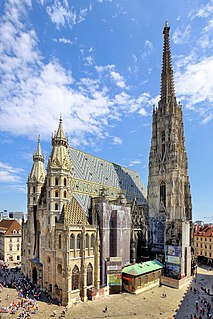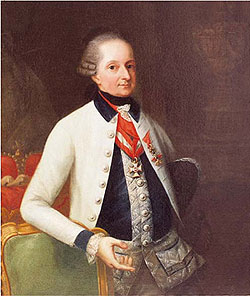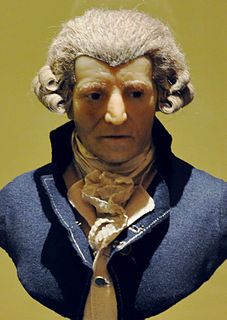Johann Evangelist Haydn (December 23, 1743 – May 10, 1805) was a tenor singer of the classical era; the younger brother of the composers Joseph Haydn and Michael Haydn. He was often called "Hansl", a diminutive form of "Johann".
Tenor is a male voice type in classical music whose vocal range lies between the countertenor and baritone. The tenor's vocal range extends up to C5. The low extreme for tenors is roughly A♭2 (two A♭s below middle C). At the highest extreme, some tenors can sing up to the second F above middle C (F5). The tenor voice type is generally divided into the leggero tenor, lyric tenor, spinto tenor, dramatic tenor, heldentenor, and tenor buffo or spieltenor.

A composer is a musician who is an author of music in any form, including vocal music, instrumental music, electronic music, and music which combines multiple forms. A composer may create music in any music genre, including, for example, classical music, musical theatre, blues, folk music, jazz, and popular music. Composers often express their works in a written musical score using musical notation.

Franz Joseph Haydn was an Austrian composer of the Classical period. He was instrumental in the development of chamber music such as the piano trio. His contributions to musical form have earned him the epithets "Father of the Symphony" and "Father of the String Quartet".
Johann was the eleventh child of Mathias Haydn and Anna Maria Koller Haydn (Joseph was second, and Michael sixth). His career training may have been mixed. According to Albert Christoph Dies, an early biographer of Joseph Haydn, Johann followed his older brothers in serving as a choirboy in St. Stephen's Cathedral in Vienna. [1] However, Rosemary Hughes indicates [2] that Johann was also trained in the profession of his father Mathias, namely that of wheelwright.
Mathias Haydn was the father of two famous composers, Joseph and Michael Haydn. He worked as a wheelwright in the Austrian village of Rohrau, where he also served as Marktrichter, an office akin to village mayor.

Albert Christoph Dies was a German painter, engraver, and biographer most noted for his biography of Joseph Haydn, although it is now considered sentimental and not entirely accurate. As an artist, he is also not very well-regarded.

St. Stephen's Cathedral is the mother church of the Roman Catholic Archdiocese of Vienna and the seat of the Archbishop of Vienna, Christoph Cardinal Schönborn, OP. The current Romanesque and Gothic form of the cathedral, seen today in the Stephansplatz, was largely initiated by Duke Rudolf IV (1339–1365) and stands on the ruins of two earlier churches, the first a parish church consecrated in 1147. The most important religious building in Vienna, St. Stephen's Cathedral has borne witness to many important events in Habsburg and Austrian history and has, with its multi-coloured tile roof, become one of the city's most recognizable symbols.
Hughes describes Johann as "delicate and quite incapable of carrying on his father's business." In 1763, Johann's father died, leaving a will that specified an early financial distribution to Johann, prior to the formal division of the estate; as Jones suggests, this indicates that he was not yet able to support himself. [3] In 1765, after his stepmother had remarried, Johann left home and joined his brother Joseph, who by this time was employed in Eisenstadt as Kapellmeister to the Esterházy family. Joseph took his younger brother into his home and found him a position as a tenor in the Esterházys' church choir. Johann worked without pay, supported by his brother, for six years, after which he drew a small salary, which Joseph supplemented. [4]

Eisenstadt is a city in Austria, the state capital of Burgenland. It has a population of about 14,241 (2016). In the Habsburg Empire's Kingdom of Hungary, Kismarton (Eisenstadt) was the seat of the Eszterházy Hungarian noble family. The composer Joseph Haydn lived there as Hofkapellmeister under Esterházy patronage.
Kapellmeister is a German word designating a person in charge of music-making. The word is a compound, consisting of the roots Kapelle and Meister ("master"). The word was originally used to refer to somebody in charge of music in a chapel. However, the term has evolved considerably in its meaning in response to changes in the musical profession.
Johann was apparently not a very accomplished singer. The composer Antonio Salieri once remarked of a pupil that he "sang through the nose like Hansl Haydn". [5] Perhaps as a result, his services to the Esterházy family were limited to church music; he was not recruited to perform in any of the many operas directed by Joseph starting in the 1770s. Johann did some teaching and may have been pressed into service from time to time as an emergency music copyist. [6]

Antonio Salieri was an Italian classical composer, conductor, and teacher. He was born in Legnago, south of Verona, in the Republic of Venice, and spent his adult life and career as a subject of the Habsburg Monarchy.
It is possible that Johann was paid as a singer as a favor to Joseph; that Haydn's employer at the time (Prince Nikolaus Esterházy) esteemed Haydn's services enough to make such arrangements is suggested by a similar act later on, in which he kept on the payroll another mediocre singer, Haydn's mistress Luigia Polzelli.
Luigia Polzelli was an Italian mezzo-soprano, who sang at the Esterházy court in Hungary during the late 18th century. She was for a number of years the lover of the composer Joseph Haydn.
Johann briefly lost his job in 1775 when some "minor infraction" (Robbins Landon) brought upon him the wrath of Prince Nikolaus's estates director, the short-tempered Peter Ludwig von Rahier. The position was restored at Joseph Haydn's intervention. [7] Johann was again unemployed from 1790 (when Prince Anton Esterházy succeeded Nikolaus and abolished most of the family's musical establishment) until 1795 (when Anton's successor Nikolaus II revived it). Nothing is known about what Johann did during this time. Following his reinstatement, he continued in the service of the Esterházy family for the remainder of his life, dying in Eisenstadt at the age of 63.

Nicholas II, Prince Esterházy was a wealthy Hungarian prince. He served the Austrian Empire and was a member of the famous Esterházy family. He is especially remembered for his art collection and for his role as the last patron of Joseph Haydn.






